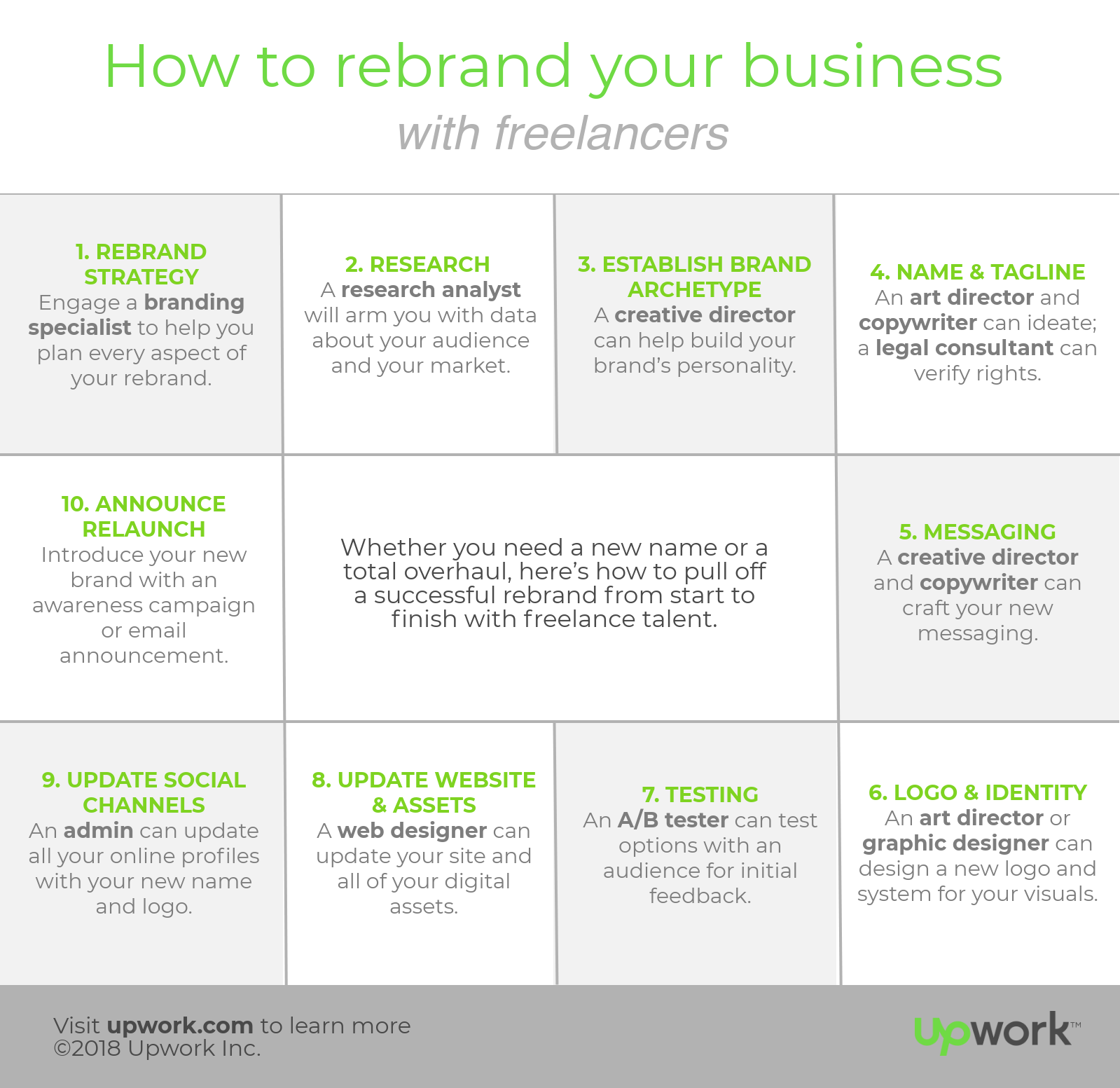Whether you have outgrown your current brand name, need to stand out in a newly crowded market, or are totally overhauling your brand, the rebrand process can be exciting. It’s a chance to put your best foot forward with a fresh logo, name, and identity. Has your business evolved, added new services, or expanded into new markets? A rebrand can more accurately reflect who you are and what you do.
But a rebrand can also be daunting. You’re suddenly aware of just how many places your logo and name appear and how many points of contact you have with you customers—business cards, website, signage, social media profiles, content, ads, and more.
With the help of freelance talent, it’s possible to pull off a successful rebrand from start to finish without disrupting your creative team’s work. The key is breaking the rebrand down into steps, then identifying who can help you at each step. Here are some tips to get you on your way.
Gauging the Complexity of Your Rebrand
Not all rebrands are created equal or require the same amount of creative muscle.
For more-complex rebrands you might need services from a…
- Branding specialist to help with planning, strategy, research, and execution
- Creative director to conceptualize a vision for your brand and oversee all of the creative execution
- Art director to deliver concepts that align with the vision and to partner with a copywriter for taglines and other messaging
- Graphic designer to execute the visuals, assets, and files
- Copywriter to craft your copy
- Web designer to update digital assets and redesign your website
- Testing specialist to ensure your new brand resonates
- Marketer to help launch your new brand to customers
For more-straightforward rebrands you might only need services from a…
- Graphic designer or art director
- Copywriter
- Web designer
Here are a few more tips to help you orchestrate your rebrand with freelance talent.
1. For more-complex rebrands, start with a strategy.
Don’t underestimate the preparation required to make a rebrand a success—it’s more involved than just redesigning a logo. For heavy-duty rebrands, you’ll want a brand strategist to help with a rebranding strategy. Ask yourself “Why do I need a rebrand? Do I just want a new name, or do I want a totally new image?” Have a clear business reason for a rebrand or you risk alienating customers and diluting your message.
2. MARKET RESEARCH CAN HELP YOU AVOID MISSING THE MARK.
It’s best to go into your rebrand armed with a thorough analysis of your current brand, your market, and your customers. A market research analyst will start you off in the right direction and prevent you from leaning too heavily into messaging that won’t resonate with your audience. A good run of investigative research can tell you everything from your target audience’s awareness and preferences to their media consumption and shopping habits so that your new direction strikes the right chord.
3. Know the difference between art direction and graphic design.
There’s a difference between executing a few files with a new logo and creating an entire identity for a brand. While all designers have an awareness of branding, not every graphic designer will have the chops to conceptualize an entire brand top to bottom.
For larger-scale rebrands, an art director—or even a creative director—is a great investment for a successful launch. For instance, a Fortune 500 company unveiling a new tagline and logo in a full-blown ad campaign will have different requirements than a small local grocer that’s shifting its focus to organic. The key is knowing what you want so you can engage the caliber of talent you need.
4. Consider engaging legal assistance for trademarks and name-checking.
The last thing you want is to update all your assets only to find out you’ve chosen the same name as another company. Trademarks can be tricky territory—and not something you want to deal with in the midst of your relaunch. Engage a legal professional to review your potential brand names and taglines while you’re still in the brainstorming phase to make sure they’re available. While you’re at it, check available domain names to make sure the URL you want isn’t taken.
5. Get a second opinion with A/B testing before you launch.
Once you’ve got mock-ups of new assets, it’s a good idea to test options with a real audience. This will help you get a sense of how your customers will respond before you commit to a direction. A freelance A/B testing specialist can take your assets and gather initial feedback on everything from logo designs and UI functionality to taglines and typography. You may love the script in your new tagline, but your audience might find it harder to read than a comparative design.
6. Take inventory of every visual asset you need to update—both print and digital.
With your brand identity, logo, and name sorted out, it’s time to tackle your assets, file by file. When engaging a designer, it’s helpful to make a list of all that you need updated—both to ensure that the designer is the right fit and to help with planning the budget and timeline. These might include:
- Business cards, letterhead, and other printed materials such as menus and service or price lists
- Outdoor signage and brick-and-mortar elements
- Video content. If you’ve created videos in the past, chances are you used your logo, brand name, and other information in title cards or lower-thirds. Engage a video editor to update your files to reflect your new brand.
Next, have a web designer help you tackle your web redesign and handle digital assets and logistics such as
- A new URL and redirects
- A temporary landing page to announce your new name
- Updating social profiles with your new name, handles, icons, Google indexing, and Yelp or Google profiles.
- SEO tactics recommended when relaunching a high-ranking website
7. Plan how you’ll communicate your brand change to customers.
Last but not least, you’ll want to have a strategy for announcing your new brand. A new name, and in some cases even a new logo, can be jarring and alienating to long-time loyal customers. You want them to know the reason behind your rebrand and to ease them in with an email, a flyer, or a post on your social media channels. You can also slowly introduce your rebrand online with a landing page, overlays, and gradual updates.

